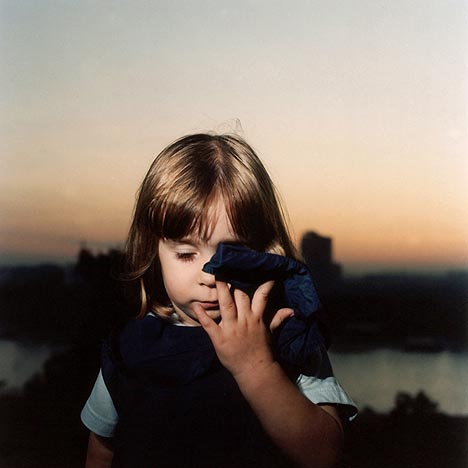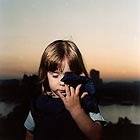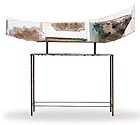
translated and summarized by: Liz Wollner-Grandville,
English summary February 2 - 8
Galerie ArtPoint: Land of Promises – Contemporary Serbian photography
A question of location
In the exhibit “Land of Promises – Contemporary Serbian photography”, not many works would be brought into connection with their country of origin. None of the artists at this exhibition, curated by the artist Ana Adamovic, deal with Serbia’s traumatic history. And if they do, then at best with more or less private memories, such as, for example Vladimir Peric with his photo series “Museum of the Childhood: Memories taken over”. His photos remind of Aby Warburg’s “Picture Atlas Mnemosyne”. Black-and-white photographs of children, mainly boys, with rocking horses – amazing how much can be found on one single theme.
The majority of the works – the exhibit claims to focus on socio-political and social issues - is less devoted to history and can be described as somewhat contemporary. The most fascinating work is Vesna Pavlovic’s photo series depicting gardens belonging to the Vlach minority in Eastern Serbia: a reared up plaster horse, a Virgin of Mercy seeming to guard the entrance, a ceramic deer with a puzzled look, angels carrying bowls with plants. These stage-like gardens clearly demonstrate the desire for cultural traditions.
Less site-specific: Uros Djuric’s photos showing the artist side by side with celebrities, such as Iggy Popp or Grace Jones; Zoran Naskovski’s photo series presenting basketball courts, Ivan Petrovic’s works showing nuclear fallout shelters. The title of the exhibit is obviously misleading. Most of the artists are not concerned with their country of origin; and that is actually commendable – as it evades the danger of exaggerated fussiness. In any case, the exhibit offers a great insight into Serbian photography.
By Nina Schedlmayer
Galerie ArtPoint / KulturKontakt Austria
1010 Vienna, Universitätsstrasse 5, until 27.02.09
www.kulturkontakt.or.at
MAK: Recollecting. Looted Art and Restitution
Life denied
With its current exhibition, the MAK attempts to document the art objects confiscated from Jews by the Nazis, as well as the restitution cases of the Republic of Austria after 1945, by presenting 17 individual cases and stories. Starting point is the “Mauerbach Auction” in 1996, which was hosted by the MAK. Christies, on behalf of the Jewish religious community, auctioned off the so-called “abandoned property” – NS looted art, which was part of the inventory of the Federal Monuments Office.
Contemporary artists, among them Carola Dertnig, Ines Doujak, and Rainer Ganahl, present their artistic connotations referring to these cases, all displayed on metal steles.
Sophie Lillie and Arye Wachsmuth’s video “Retracing the Tears”, shows the backsides of the objects auctioned at the above-mentioned sell-off, on which the former owners’ abbreviated names are easily identified. This clearly proves that the Republic of Austria could have, without any difficulty, researched the rightful owners, or their heirs, long before the auction took place in 1996.
The numerous interviews document the bitterness regarding how much time had elapsed before the objects were returned, and how troublesome the battle with Austrian bureaucracy was. They convey the impression that both those affected as well as the researchers and historians are embarrassed about how unfair the Republic of Austria dealt with the victims of Nazi atrocities after 1945. One of these victims is Otto Brill. He was arrested by the Gestapo immediately after the “Anschluss” and forced to surrender his property as well as his factory to the Nazis, otherwise he would be deported to the Dachau. He was able to immigrate to Great Britain with his family. Brill was an art collector and owned part of the Gallery Würthle. In the video, his great grand daughter narrates how tedious the restitution negotiations were, and that her grandmother did not live to witness the restitution of eight art works to her family in 2001 by the Albertina.
Carola Dertnig bases her work “Collection Brill – Questions regarding 28033 and 28034” on this story. She projects the catalogue number onto the wall, whereby the provenance of two works still in the possession of the Albertina remains unclear to this day. Dertnig presents both works: an aquarelle by Herbert Boeckl and a drawing by Stefan Pichler, which were probably part of Brill’s collection. The question how these works actually changed hands – possibly as a “free bonus” or a present for the Gestapo – remains unanswered.
Nobody knows how Lily Bial’s felt when she learned that a box filled with childhood-memorabilia, put together by her parents, had suddenly shown up. Lily survived the holocaust in Great Britain thanks to a “Kindertransport” in 1939; her parents were murdered in Ausschwitz in 1942. The box is displayed at the MAK and is filled with photos, a doll’s china set, coffee bean boxes, and many other memories. It is one of the most touching objects and proves that even an object without real history is a document for the “dehumanization” (Felicitas Heimann-Jelinek) of a society.
By Susanne Rohringer
MAK-Applied Arts/Contemporary Art
1010 Vienna, Stubenring 5, until 15.02.09
www.mak.at
Konzett Wien: Rudolf Polanszky – Transaggregate structures
Impossible bottles for a modern living room
Rudolf Polansky’s works, currently displayed at the Gallery Konzett, are by all means charming compositions, however, they lack the ability to convince. Most probably because they strike the onlooker as too well behaved. It is unfortunate that their conceivable, but hidden characteristics of being free and wild were lost somewhere along the line.
The glued and deformed Plexiglas objects, resembling impossible bottles, are mounted on crudely welded steel stands and, on account of their height, can only be viewed from underneath. Large collages made of tinfoil, colours, and diverse additional materials, as well as Plexiglas complement the show. Irrespective of the material, the works follow the tradition of Tàpies and Twombly. However, in contrast to Twombly’s sculptures, his originals do not meet the expectations raised by the photos of Polanszky’s works. On the contrary, the originals make it clear how uncaring the pictures and sculptures are assembled. Not only the obvious indifference for details is irritating, but also the fact that this indifference completely destroys the fascination created by experimenting with materials and forms. They are appealing as status symbols – devoid of being kitschy or uptight. And this definitely makes them superior compared to most of the gaudy kitsch available.
By Wolfgang Pichler
Konzett Wien
1010 Vienna, Spiegelgasse 21, until 28. 02. 09
www.artkonzett.com
Kunstraum Niederösterreich: New Folks
Multicoloured scarcity value
Esther Strauß attempts to climb a tree and fails grandiosely. Three artists – Clemens Denk, Philipp Hanich, Thomas Weinberger are eating scoops of multicoloured ice cream from a colour palette. Ursula Maria Probst, alias female obsession and artmagazine-author, destroys a wall with a jackhammer, on which the words “everyone says I love you” is written in cursive handwriting.
The exhibit at the Kunstraum Niederösterreich is definitely not boring. Its colourfulness corresponds with the basic undertone of this exuberant show, for which the artist and curator, Ursula Hübner, gathered some of her students from the University of Arts in Linz, as well as renowned colleagues, whose works clearly show an “urgent, optimistic movement, not allowing for any stagnation or chic cynicism."
But it would be amiss to think that this exhibition is excessively cheerful –accounting for the multi-tasking of some participants, the title “New Folks” refers to the respective music style. While many of the works appear to be rather zappy – like Marlene Haderer’s neon-coloured paintings, Andrea Lüth’s drawings, or Andreas Karner’s ornamental excesses, it soon becomes clear that this is not the carnival section. The trio, mentioned above, which performs under the name “Kraftmalerei” (power painting) installed a kind of wonder chamber for art application at the entrance to the show, in which one can find bottles of sparkling wine under the brand name “Michelangelo”, or the cover of a porn movie called “The quick brushes”. On the other hand, the artwork by these three, who also work individually, comes across as rather serious, nearly old masterly. And even Birgit Petri’s fine etchings, a real discovery, play with the relationship between text and painting.
Thematic exhibitions, which are not only well done, but also offer a statement, a position, are rare. “New Folks” is definitely one of them.
By Nina Schedlmayer
Kunstraum Niederösterreich
1010 Vienna, Herrengasse 13, until 21. 02.09
www.kunstraum.net
Mehr Texte von translated and summarized by: Liz Wollner-Grandville


 Teilen
Teilen





